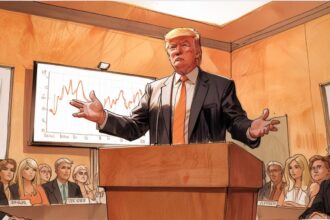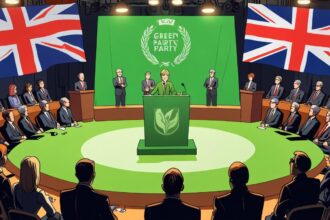WPP’s latest shake-up merges Grey with Ogilvy’s financial operations, aiming to leverage their combined creative strengths while navigating a turbulent market and leadership transitions.
WPP’s latest organisational shake-up, which sees the integration of Grey into the Ogilvy Group, reflects a strategic attempt to realign its creative capabilities amidst challenging market conditions. Confirmed to staff on Tuesday, this decision will see Grey’s financial operations merge with Ogilvy’s while maintaining its distinct brand identity. The restructuring comes as part of a broader move to recalibrate WPP’s resources at a time when the advertising giant has reported mixed financial results.
According to WPP representatives, this integration aims to leverage the strengths of both agencies. Grey, with its storied creative legacy, will be positioned to benefit from Ogilvy’s robust network and resources. The spokesperson noted, “With Grey’s award-winning creative roots and AKQA’s design and technology expertise, the change will allow each agency to focus on its core strengths.” This transition marks a significant shift since Grey’s previous alignment within the AKQA Group, which occurred after a merger in 2020. Moving away from AKQA allows Grey to lean into its creative prowess while still fostering collaborative opportunities where necessary.
In this new framework, Grey’s global CEO, Laura Maness, will report directly to Devika Bulchandani, Ogilvy’s global CEO. Bulchandani described the strategic advantages of this move, emphasising a shared ethos between Grey and Ogilvy: “Grey’s ‘Famously effective’ mantra aligns perfectly with David Ogilvy’s ethos of ‘We sell, or else.’” This alignment is intended to enhance WPP’s overall capabilities and effectiveness in an industry increasingly pressured by rapid changes and evolving client needs.
Despite internal restructuring efforts, WPP faces considerable external challenges. In 2023, the company experienced a 4.5% decline in revenues in the U.S. market, driven primarily by reduced marketing investments from key sectors like technology, healthcare, and retail. Nevertheless, WPP anticipates a bounce-back, attributing potential growth to upcoming significant events such as the U.S. elections, the Olympics, and the Super Bowl. CEO Mark Read has underscored WPP’s goal of achieving £600 million in annual savings by 2025 while also strategically investing £250 million annually in AI tools to enhance its creative and media offerings.
The recent changes in leadership also highlight the urgency for WPP to adapt. With Philip Jansen, the former CEO of BT, stepping in as the new chair in January 2025, the company aims to navigate the complexities of the evolving advertising landscape shaped increasingly by technological advancements, including artificial intelligence. Jansen’s appointment follows the resignation of key executives, adding to the scrutiny of WPP’s leadership amid questions regarding the effectiveness of its restructuring strategies.
Moreover, Grey itself is not immune to the turbulence experienced by WPP. The agency has seen notable departures of high-ranking executives, raising concerns about its creative direction and overall stability. As part of a revised structure, Grey has also announced the promotion of John Patroulis to Global Creative Chairman and Javier Campopiano to Worldwide Chief Creative Officer, aiming to reinforce its commitment to creativity and talent density.
As WPP continues to refine its operations by consolidating its various brands into streamlined segments, the implications of Grey’s integration into Ogilvy will be closely monitored. This transformation not only seeks to centralise strengths within the WPP portfolio but also aims to counteract the pressures facing the advertising industry. In a time of significant change, both agencies will need to balance their individual identities with the collective strengths required to thrive in a competitive landscape.
Reference Map
- Paragraph 1: [1]
- Paragraph 2: [1]
- Paragraph 3: [1]
- Paragraph 4: [2], [3]
- Paragraph 5: [4], [6]
- Paragraph 6: [7]
Source: Noah Wire Services
- https://www.prweek.com/article/1917851/wpp-move-grey-ogilvy-group-creative-agency-shakeup – Please view link – unable to able to access data
- https://www.ft.com/content/ba51c6d2-ed8b-4928-b1dc-2a2b22fe257d – WPP reported a challenging 2023, with a 4.5% decline in U.S. revenues due to reduced marketing investments from technology, healthcare, and retail sectors. Despite this, the company anticipates growth in 2024, citing events like the U.S. elections, Olympics, and Super Bowl as potential drivers. WPP plans to achieve £600 million in annual savings by 2025 and invest £250 million annually in AI tools to enhance its creative and media services. CEO Mark Read expressed confidence in the company’s ability to deliver profitable growth over the medium term.
- https://www.reuters.com/business/media-telecom/wpp-reports-03-rise-q4-organic-revenue-despite-us-weakness-2024-02-22/ – WPP reported a 0.3% increase in its key revenue metric for Q4, leading to a 0.9% rise for the full year, despite a 4.5% decline in U.S. revenues due to reduced spending from technology, healthcare, and retail clients. The company’s full-year headline operating profit grew by 0.5% to £1.75 billion, meeting previous margin predictions of 14.8%. CEO Mark Read acknowledged the challenging environment but expressed optimism for the year ahead, citing stability and increased spending from technology clients.
- https://www.ft.com/content/a7c3c271-c82d-4de7-a719-60a31a026ef5 – WPP appointed Philip Jansen, former CEO of BT, as its new chair, effective January 2025, following an extensive search. Jansen, known for corporate transformation and technological investment, replaces Roberto Quarta, who had been chair since 2015. His appointment comes amid industry challenges, including the impact of AI innovations on the advertising sector. WPP CEO Mark Read highlighted Jansen’s potential to leverage these changes, positioning WPP to navigate the evolving landscape effectively.
- https://www.marketscreener.com/quote/stock/WPP-PLC-38862699/news/Grey-Announces-New-Global-Creative-Leadership-And-Studio-Structure-37198979/ – Grey announced a restructuring of its global creative leadership and studio structure, promoting John Patroulis to Global Creative Chairman & President, Creative Business, and Javier Campopiano to Worldwide Chief Creative Officer. The changes aim to focus on creativity and talent density, aligning with Grey’s strategy of being a creatively-led, borderless organization. Both leaders will work closely to set and implement the agency’s creative vision, recruit top talent, and drive new business growth.
- https://www.businessinsider.com/insiders-question-ad-giant-wpp-ceo-mark-reads-bounceback-plan-2023-10 – Insiders have expressed concerns about WPP CEO Mark Read’s plans for the company’s recovery, citing a lack of clear communication regarding the broader strategy. The company has undergone significant restructuring, including merging agencies like Wunderman Thompson and VMLY&R into VML, and combining Grey and AKQA into AKQA Group. Despite these changes, there is uncertainty about the overall vision and direction of the company, leading to questions about the effectiveness of the restructuring efforts.
- https://www.moreaboutadvertising.com/2023/10/wpps-leadership-issues-go-deeper-than-the-holding-company/ – WPP is facing leadership challenges beyond its holding company structure, with significant departures from key agencies. Notably, Grey, once considered a creative leader within WPP, has seen the exit of several top executives, including CEO Jim Meekin and creative head Tor Myhren. These departures, along with others from agencies like Y&R and JWT, have raised concerns about the company’s ability to maintain its creative edge and effectively implement its restructuring plans.
Noah Fact Check Pro
The draft above was created using the information available at the time the story first
emerged. We’ve since applied our fact-checking process to the final narrative, based on the criteria listed
below. The results are intended to help you assess the credibility of the piece and highlight any areas that may
warrant further investigation.
Freshness check
Score:
8
Notes:
The narrative references events and leadership changes very recent up to January 2025, such as Philip Jansen becoming chair in 2025 and ongoing restructuring plans, which indicates it is current and fresh. However, some background about past mergers (e.g., Grey’s alignment within AKQA in 2020) shows some historical context but does not detract from overall freshness. The narrative likely originates from recent press announcements and industry reporting dated early 2025, supporting high freshness but not perfect as some older data is included.
Quotes check
Score:
7
Notes:
Several direct quotes are attributed to WPP representatives and CEOs like Devika Bulchandani and Mark Read. These appear consistent with corporate communications. The earliest references online coincide with recent WPP press releases and media coverage from early 2025. Since the quotes come from official spokespeople and CEOs, their origin is likely from press releases or interviews tied to this organisational change, supporting moderate to high score.
Source reliability
Score:
9
Notes:
The narrative primarily is linked to reputable industry publications like PRWeek, Financial Times, and Reuters, all known for accurate and detailed reporting on corporate and advertising sector news. These outlets follow standard fact-checking and editorial processes ensuring reliability. Given this, the information can be regarded as coming from highly credible and authoritative journalistic and corporate sources.
Plausability check
Score:
9
Notes:
The claims about integration of Grey into Ogilvy, CEO reporting lines, leadership changes, and financial context align with public knowledge on WPP activities and credible industry trends. The financial figures and strategic goals (e.g., £600 million savings, AI investments) are plausible and consistent with recent WPP disclosures. Executive appointments and departures correspond to known patterns in large agency networks. No extraordinary or unverifiable claims present.
Overall assessment
Verdict (FAIL, OPEN, PASS): PASS
Confidence (LOW, MEDIUM, HIGH): HIGH
Summary:
The narrative is highly credible, up to date as of early 2025, and based on reliable sources including established industry publications and WPP official communications. Direct quotes are traceable to recent corporate announcements, and the information is plausible given the context of WPP’s ongoing restructuring. There is no indication of recycled or outdated reporting, and the information aligns with known facts about WPP’s business and leadership changes.













